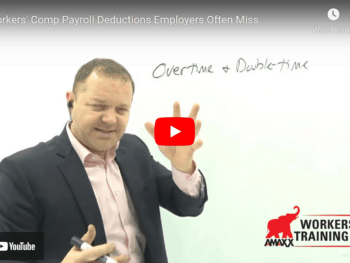No employer sets out to waste money on workers compensation, but many employers do so unwittingly. The following seven myths are financial mistakes often made by employers in the handling of their workers compensation insurance program.
1. Workers Comp is a Cost of Doing Business
Too many employers think of workers comp as a state mandated expense, just a cost of doing business which cannot be controlled. However, a properly managed workers comp program can have a major impact on the cost of workers comp by avoiding the cost of claims through a safety program, and by controlling the cost of claims through claim management and medical management. The cost of the workers comp program should be viewed in terms of the return on investment. When approached from this perspective, the financial profitability of managing workers compensation is absolute.
2. Injured Employees are a Drain on the Company
When an employer wishes an injured employee would “just go away,” they are making a terrible mistake. The cost of employee turnover (due to workers comp or any other reason) has a negative impact on the profitability of the company. Depending on the industry, the cost of hiring, training and supervising a new employee can be from 50% to 100% of the annual salary for the job position. (WCxKit)
Instead of treating the injured employee as a nuisance, the employer is much better served by communicating with the employee that they are needed at work. The employer who has a return to work program in place prior to an injury, and who offers the employee a modified duty position until the employee is able to handle their prior job fully, will benefit through lower cost of employee turnover and lower indemnity cost.
3. Workers comp Can be Measured by the Cost of the Premium
If an employer thinks the way to measure the cost of workers comp is by the price of the insurance premium, they are measuring only a small part of the total cost of workers compensation. The cost of workers comp not only includes the direct cost of the premium, but also includes the much larger indirect cost of lost production, lost supervisory time, temporary replacement cost or overtime cost, increased training, equipment or property damage, lower morale and unhappy customers.
4. The Insurance Carrier should be Selected Solely on Price
It is tempting for an employer to think all insurance carriers are alike and to make the selection of the insurance company (or the third party administrator if self insured) based on the price quoted. The wise employer looks beyond price to the quality of service the insurance carrier provides. The quality of the claim handling by the insurance carrier should be the primary factor. A low initial price for the insurance coverage will not last very long if the claim handling quality is poor, as the experience modification factor will come into play in calculating the next premium. The financially savvy employer investigates the level of service provided by each insurer under consideration and the track record of the insurers in raising (or lowering) the premium charged.
5. The Broker Relationship is Unimportant
When the broker and the employer have a relationship only as salesperson and customer, the employer loses out on a valuable resource. If the employer selects a broker who has an in depth understanding of workers compensation, a partnership in controlling and managing the workers comp cost can then develop. With a strong relationship between the employer and the broker, the employer has a knowledgeable source of information readily available to assist with the management of the workers comp program.
6. Lower Job Classification Rates will Equal Lower Cost
Employers often believe that a reduction in the job classification rate means a lower cost of insurance. That is not always so. The calculation of the workers comp premium is based on the job classification code rate, the total amount of payroll and the experience modification factor. The calculation of the premium is: the job classification rate X $100 of payroll X the experience modification factor. If the employer has had higher than average workers comp cost compared to other employers with the same job classification codes, the overall cost of workers compensation will most likely increase due to the higher experience modification factor being used to calculate the insurance premium. (WCxKit)
7. Safety Programs Cost Too Much
Unenlightened employers when faced with lower profit levels often look at the safety program as a place where cost can be cut. When safety programs are cut or eliminated, there is an increase in both the number of work place injuries and the severity level of the injuries. The experience modification factor shoots higher, resulting in significant increases in the cost of the workers comp insurance premium.
Summary
Workers comp myths are easy to believe. The common factor through all the myths is taking the path of least effort. When the employer puts forth the effort to understand workers compensation and to properly manage the workers comp program, the myths fade away and are replaced by sound financial decision making.
Author Rebecca Shafer, JD, President of Amaxx Risks Solutions, Inc. is a national expert in the field of workers compensation. She is a writer, speaker and website publisher. Her expertise is working with employers to reduce workers compensation costs, and her clients include airlines, healthcare, printing/publishing, pharmaceuticals, retail, hospitality and manufacturing.
Contact: RShafer@ReduceYourWorkersComp.com or 860-553-6604.
Contact: RShafer@ReduceYourWorkersComp.com or 860-553-6604.
Join WC Group: http://www.linkedin.com/groups?homeNewMember=&gid=1922050/
Modified Duty Calculator: http://www.LowerWC.com/transitional-duty-cost-calculator.php
Do not use this information without independent verification. All state laws vary. You should consult with your insurance broker or agent about workers comp issues.
©2010 Amaxx Risk Solutions, Inc. All rights reserved under International Copyright Law. If you would like permission to reprint this material, contact Info@WorkersCompKit.com.


















It’s great that you elaborated on the fact that if safety programs and their budgets are cut, then it leads to more risk of an employee getting hurt. My brother runs a company where they are trying to decrease onsite injuries. I will pass this along to him as he tries to work with the company’s worker’s compensation.